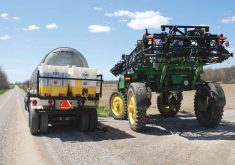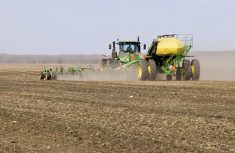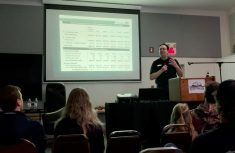Overview
A number of fields in the Southwest region were seeded post-June 20th, leading to a small increase in planted acres. Some of these areas were low spots that could now be seeded, but most have been seeded via a floater, to either canola or greenfeed/cover crop.
Severe weather and heavy rains have damaged crops in parts of agro-Manitoba, notably in the Southwest and Northwest regions, where up to baseball-sized hail destroyed crops and damaged farm infrastructure near Binscarth and Russell. Crop recovery from last weeks’ storm in the Northwest region was evident, but crops are expected to be delayed as a result.
Read Also

Seeding Indigenous agricultural prosperity
National Circle for Indigenous Agriculture and Food says Indigenous agricultural success needs strong relationships.
Continually wet soils have slowed seeding and spraying progress again. There were over 880,000 acres left unplanted as of June 20 seeding deadline, concentrated in the northwestern Interlake, along Lake Manitoba, in the Austin-Gladstone-Portage la Prairie area, and adjacent to the Red River. However, seeding post-insurance deadline has resulted in over 150,000 acres being planted, mostly in the Southwest region, bringing the unseeded acreage estimate down to just under 700,000 acres.
Repeated rains and warm soils have led to widespread nitrogen fertilizer losses, either via leaching or denitrification. In-crop nitrogen-deficiency symptoms are showing up as chlorotic (yellowed) leaf margins, in combination with other symptoms of crop stress due to saturated soils. A drop in nitrogen prices (down approx. 30 per cent from spring highs) may encourage in-crop top-dressing. The rush to seed crops wherever possible led to poorer seedbeds in some cases, which will impact in-season management and harvested yields.
Ag retailers are dealing with short-supply issues of glufosinate (Liberty) herbicide, and short-season crop seed. Short-season seed is either destined to be a reseed or uninsurable late-seeded grain (barley) or forage (millet, sorghum) crop. Spraying progress has rapidly advanced, despite challenging winds and very wet fields. Aerial application is widespread for insect control, while ground sprayers attempt to manage weeds. Rutted fields and stuck sprayers are common this year, and most spraying has had to be done in the evenings or early mornings when winds are calmer. Many canola fields have yet to be sprayed for the first time, and weed pressure is high.
Humid and warm conditions are ideal for fusarium and sclerotinia (white mould) disease development this year, and many farmers and retailers are preparing to spray fungicides on wheat, canola, and peas (for mycosphaerella) when conditions permit and crop development advances.
Cereals
Spring wheat crops have generally received the first herbicide pass, and are tillering to beginning to see stem elongation (jointing). Later seeded cereals are at 2- to 4-leaf stage.
Rapid growth in cereals under warm and moist conditions are showing signs of temporary nitrogen deficiency in some fields, but mostly recovering as roots expand. Some producers are top-dressing urea or UAN.
Fall rye is in the grain-fill stage, while winter wheat crops have received a FHB fungicide application.
Barley and oat crops are at 4- to 6-leaf stage, some early barley crops near Arnaud at flag leaf.
Grain corn development ranges from V4 to V6 (collar method), producers are considering top-dressing in some instances, and most farmers are about to begin a second herbicide pass.
Grasshopper nymph feeding damage has been reported in many crops in the Southwest, Central, and Interlake regions. Farmers and agronomists are encouraged to monitor grasshopper levels, stage and
feeding in crops and vegetation around fields. If there is already heavy feeding to crops, a good time to start applying grasshopper control, is when the wing buds are becoming noticeable in the majority of grasshoppers.
Oilseeds
Canola crops range from cotyledon to late rosette stage, with a few (relatively) early sown crops bolting and beginning to bloom. Most canola is between 4- to 6-leaf stage, where not excessively damaged by flea beetles.
Herbicide application in canola is ongoing as crops and weeds move into the correct stage, and field access permits. Glufosinate-herbicide shortages have forced farmers to wait for product, or time a single application very carefully to achieve the greatest weed control impact.
Many canola fields have not yet been sprayed for weeds, weed pressure remains high on those crops as sprayers are unable to access wet fields, and getting stuck is a serious problem.
Foliar application for flea beetles is widespread in canola fields in all regions. Flea beetle pressure has been heavy, yet inconsistent, with some fields requiring four or more foliar insecticide applications while nearby fields at similar stages have seen only minor damage. Later-seeded canola is consistently growing better, and seeing less damage and more rapid growth than earlier, more affected crops.
Most canola crops are now moving past flea beetle damage, but a few remain alive but have stalled growth.
Canola seeding completion is estimated at 85 to 95% of initial forecasted acres.
Flax has largely received the first in-crop herbicide, some farmers have split broadleaf/graminicide herbicide application in order to reduce crop stress and allow recovery. A few crops are reporting herbicide injury from drift off neighbouring fields.
Sunflowers are now at V4 to V7, some grasshopper damage noticeable as leaf area expands, farmers are now beginning inter-row tillage for weed control in conventional sunflowers. Sunflower crops appear in great condition.
Pulses
Soybeans are now established, and range from first trifoliate (V1) to second trifoliate (V2).
Soybean crops remain quite short in stature due to later planting dates, but are expected to switch into
reproductive mode towards the end of the coming week, post-solstice.
Herbicide applications in soybeans are the most advanced, due to the broad spray window in that crop
compared to cereals and canola.
Field peas range from V3 to V12 stage, and in-crop herbicide application is complete in most crops.
Fungicide application has started for field peas in the Southwest and Northwest regions as peas begin to flower.
Hail on pea crops did cause severe damage in affected regions, but recovery is possible in most cases with expected maturity delays. Yield losses will be more severe if heavy rains left standing water.
Dry edible bean crops have seen in-crop herbicide applied beginning last week, ongoing on fields as beans each 3rd trifoliate in the Red River Valley, and appear in very good condition.
Dry bean fields with pre-emergent herbicide have much better weed control and appear very clean.
Forages & Livestock
Forages
Alfalfa stands are now in the bud stage, and producers targeting higher-quality hay have begun cutting.
Hay yields are expected to be at or above normal, well-managed pastures are seeing grass height over 4
feet (120 cm) and heading out.
Pasture condition is rated good to excellent in the Northwest region, with exceptions from Dauphin
southward suffering from excess moisture, and into the western and northern Interlake region.
Haying progress in the Eastern region is hampered by frequent rains, stopping cutting soon after getting
started. Hay quality does appear good, and yields are much improved over 2020 and 2021.
Low numbers of lygus bugs reported, and minimal damage in alfalfa crops for both forage and seed.
Hayfields and pastures would benefit from heat and drier weather, needed for the upcoming haying season.
Most pastures seem to be keeping up with cattle feed demand, and pasture production has greatly improved with recent warmer weather and regular moisture. Beef cattle producers are generally pleased with pasture performance this year, given the challenging environmental conditions and slower recovery from 2021.
Livestock
Reports of foot rot treatments and high black fly populations in some pastures.
Dairy farmers are in middle to end of their first cut in the Eastern region, and beef cattle producers have
started first cut on fields that are dry enough to support machinery, but leaving some ruts.
Cattle are forced to swim to find edible pasture in parts of the northern Interlake, and are unable to access any lowland pastures, where standing water is abundant.
All creeks, streams, dugouts, and sloughs are full to overflowing.
Regional Comments
Southwest
Warm temperatures and high humidity have favoured good growth conditions for crops. Strong winds following rain storms has made daytime herbicide application challenging, forcing many farmers to spray into the evening or early morning hours.
A major storm system moved through Foxwarren/Binscarth and Rossburn/Oakburn areas last week, with meteorological stations reporting very high winds in excess of 100 km/hr, and farmers reporting up to baseball-sized hail near Russell, destroying some crops and farm infrastructure. Warm, calm, and dry weather is needed for crops to recover.
Seeding progress advanced to 95 per cent complete, leaving approximately 5 to 7 per cent of all acres left unseeded. Some low-lying areas will be abandoned or have seed and fertilizer floated on.
Northwest
Unsettled weather arrived over the weekend after a few nice growing days, bringing as much as 100 mm rain in the McCreary area, lessening towards Laurier and Ste. Rose. Fields in that region are again underwater, after being some of the driest in the region in 2021. Unseeded acres are approximately 50-60 per cent of total arable land in this district, while the region overall has 89 per cent of crops planted. Unseeded acres also remain in the Grandview-Gilbert Plains-Dauphin districts (15 to 30 per cent), and the Fork River area (30 per cent).
Overnight lows are still dipping below 10 C, crops require more heat to achieve rapid growth. A severe storm system moved through late last week, with baseball-sized hail destroying some crops in the Binscarth area, together with a tornado touchdown. Benito-area crops are being assessed for damage from the previous storm, with some crops recovering with further maturity delays expected.
Central
Herbicide spraying is nearly complete in cereal crops in the region, and most soybeans as well. First pass in flax, sunflowers, and corn is complete. Flea beetle issues persist on earlier-seeded canola crops that cannot seem to grow past the feeding damage, spraying is ongoing but starting to slow west of the escarpment and nearly done in the Red River Valley.
Early spring wheat crops are reaching flag leaf, crops look in very good condition south of PTH 3, and less advanced further north, with a few more drowned out spots due to higher rainfall amounts. Some top-dressing of cereals is occurring.
Eastern
Rainfall accumulations last week across the region varied from 10 to over 75 mm, mostly falling on Friday, June 24. Standing water persists in some fields, but spraying and hay cutting activities have resumed. Temperatures across the region were erratic, above normal prior to the weekend, and cooling rapidly as storms systems moved through the area.
The few remaining unseeded acres in the region will remain unseeded to an annual crop. The region sits at 97 per cent complete. Pasture performance has improved, and dairy producers are generally nearing the end of first-cut, while most beef cattle producers have yet to start.
Interlake
Rains again last week have kept fields saturated, and excess moisture has caused crop loss in low spots and caused uneven emergence across fields. Overland flooding has led to large areas of rotted cereal and canola seed in the north Interlake, while some soybeans appear to be managing better. Huge uncertainty remains, especially in the north and central Interlake about the possibility of even planting greenfeed crops on unseeded acres before July 15. Silage corn growers and beef cattle producers have backed off the majority of their silage crop due to not meeting the crop insurance deadline of May 31st, and are very concerned about going another year without adequate feed production.
Spraying for flea beetles continues across the region, with variable results. Saturated canola fields are suffering more from excess moisture than flea beetles, so sprays may be decided against in some cases. Approximately 50% of fields remain unseeded west of Arborg towards Fisher Branch and Lundar, and crops that are in the ground have suffered greatly from excess rains and lack of drainage.
Southern Interlake conditions are better, where crop growth has been better and more uniform, but larger drowned- out spots still visible. Spraying is underway, both by air and ground. Approximately 25 per cent of fields remain unseeded in the Petersfield-Matlock-Winnipeg Beach area. Overall, regional seeding progress sits at 87 per cent.















